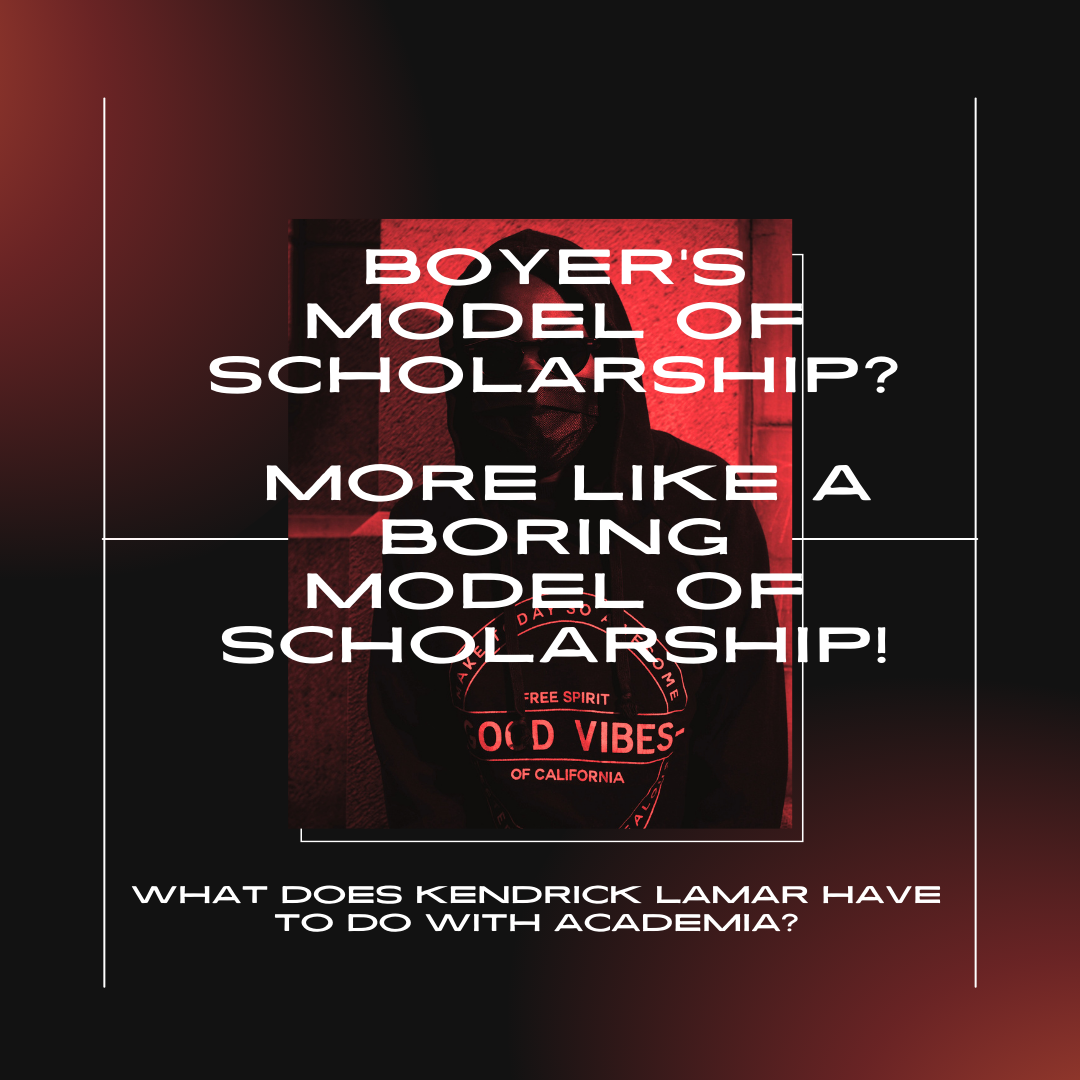I’m working on a presentation for a symposium on innovation and collaboration(Impact Symposium, register here 😉). As is my way, I like to work out my thought process in writing. So, welcome to my workshop.

One of the things I’m presenting is Boyer’s model of Scholarship and its place in applied research. Before I dig into why his model is so boring (relax, it’s not, but I do have some suggestions), it’s crucial to acknowledge why Boyer’s model holds such importance in the scholarly world.
Boyer’s model, introduced in 1990, challenged how we understood and valued different types of academic work. It categorized scholarship into four distinct but interrelated areas:
- Discovery: The quest for new knowledge.
- Integration: Connecting insights across different fields.
- Application: Using academic research to address societal needs.
- Teaching: Educating and engaging students in the learning process.

This model broadened the scope of what constituted scholarship, moving beyond the traditional focus on original research to include the integration of knowledge across disciplines, the application of knowledge to societal problems, and the art of teaching.
Everything is a Remix
Boyer’s Model, offering a structured view of scholarship, could lead to a segmented approach. Like a hip-hop track (and I’m talking Kendrick Lamar here, not that mumble rap garbage like Lil Yachty), where distinct elements like beats, lyrics, and samples exist independently, the beauty of (some) hip-hop lies in mixing these elements, crafting a dynamic, seamless fusion. Similarly, the real excitement and innovation could occur in academia when the separate facets of Teaching, Discovery, Integration, and Application in Boyer’s Model intertwine.

Lately, I’ve developed a mini obsession with Kirby Ferguson’s video series “Everything is a Remix.” Ferguson claims that creating anything fresh and new is a process of remixing. Creativity is about copying, transforming, and combining existing ideas.
When I started digging into Boyer’s Model of Scholarship a few years ago, the parallels were striking. Boyer’s overlap of Teaching, Discovery, Integration, and Application demands a remix approach. By rethinking Boyer’s four areas in the context of Ferguson’s insights, we can reframe scholarship as a creative act—copying, transforming, and combining ideas to forge new paths in education and research. This fusion enriches the learning experience and reinvigorates the scholarly process, much like the groundbreaking remixes in music and art that Ferguson celebrates.

In the spirit of “Everything is a Remix,” Boyer’s Model of Scholarship can be reimagined as an academic remix, bringing together the components of Teaching, Discovery, Integration, and Application in a way that echoes the creative processes outlined by Ferguson. This remixing within academia aligns with the idea that innovation often arises not from creating something entirely new but from reassembling existing pieces in novel ways.
It’s given me freedom to create, by transforming existing elements and combining them to create something new. Everything is a remix!
Kirby Ferguson
Just as Ferguson discusses how remixing can democratize creativity, so too can Boyer’s Model be seen as a framework for intellectual remixing. It enables scholars to create expansive and complex ideas from the foundational elements of their disciplines without the need for expensive resources or traditional gatekeepers.
So What?

In academic innovation, the remixing of Boyer’s model of Scholarship offers a transformative perspective, not just in traditional academic fields but also in disciplines often overlooked in scholarly discourse. This remix approach posits that creativity in academia, akin to the artistry in music, stems from the fusion of existing elements – Discovery, Integration, Application, and Teaching. It’s about reassembling these components in novel ways to spark new insights and solutions. Such a remix could revolutionize how various fields approach learning and innovation. For instance, in a trade like carpentry, this could mean integrating environmental science for sustainable practices or, in fields like digital media, applying technological advancements to traditional storytelling techniques.
Embracing a ‘remixed’ version of Boyer’s model transforms the landscape of scholarship into a vibrant, interconnected network of ideas and practices. This approach acknowledges innovation’s chaotic yet creative nature. By applying this philosophy, various disciplines can weave together knowledge and skills in unique combinations, paving the way for a more inclusive and impactful scholarship. Such a fusion in academia not only enriches the learning experience but also reinvigorates the scholarly process, echoing the groundbreaking remixes in art and technology that continually reshape our world.
As Bob Dylan says, Chaos is a friend of mine.

Boyer’s Model of Scholarship need not be boring. By embracing a ‘remixed’ approach, we can transform it into a dynamic, interconnected network of scholarly activities. This approach makes scholarship more engaging and reflects the real-world process of innovation – a lively, creative, and often chaotic interplay of ideas. Just as Kendrick Lamar’s Pulitzer Prize-winning album “DAMN.” masterfully blends diverse musical and thematic elements into a groundbreaking work, there’s an exciting opportunity to weave together the facets of Boyer’s model with similar creativity. Sure, there’s a chance we create something chaotic and unruly, but isn’t there something beautiful about that?
Shared by:

Sorry, but comments are not enabled on this site.